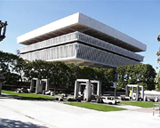Great moments are briefly conjugated in the present tense and then they go down to History. This is where the documentation and preservation process begins. The results, stored in museums and historic sites and historic houses, are rarely boring to watch -- they connect with the moments that have defined our own present.
And Albany is an A student in this. It has amazing museums and preserved sites that will transport you back to the times when New York was still fighting to be capital of the world.

From the bacteria that first inhabited the state billions of years ago to the September 11, 2001 attacks -- All things New York can be found in the senior Natural History Museum of America. Its permanent exhibitions (which include the state's native bird species, a full-sized carousel from the 1910's and the actual skeleton of a mastodon) are the perfect counterpoint to the over-romanced descriptions of both New York City and its state.
It comes as no surprise that what started out in 1836 as "a comprehensive collection of the natural productions of the State of New York to exhibit under one roof", as its founder, Governor William Macy, put it quickly evolved from storing fossils and rocks to hosting thousands of historic materials and art. Making its location all the more ideal (and its visit all the more recommended), the museum's current facility, the Cultural Education Center, is on Albany's Empire State Plaza actual faces New York's Capitol.
If the Museum is New York's medical history and the Capitol its brains, the New York State Archives are its memory. There are 200 million documents in it, from the Dutch rule to the British rule, from the evolution of public education to the rise of the environmental movement. It's located in the same building as the Museum, so it's always worth a hike to the fifth floor (where the Museum ends and the Archives begin) to see history taking shape in the hands of hard-working researchers taking strenuous looks at documents as old as the city around you.
If you have the time, climb up to the 11th floor to see the New York State Library, owner of several collections documenting the State's history and genealogy. So go ahead, and dare to have any doubt while you are there.

Out of the many religious movements that populated the United States in colonial times, few have influenced the country as subtly as the Shakers. An animated version of the Quakers, their ideals developed around the systematic rejection of sex -- their sexless life spawned notions of gender equality (quite the puzzling notion in the 1770's), impeccable work ethics and a devotion to excellence both in arts and crafts. It also meant that Shakers could not have children. Thus, they gradually disappeared.
When they weren't praying having visions from the angels (both things actually took a lot of their time), the Shakers spent all day long working. The products they sold -- simple, functional furniture; durable utensils like baskets or brooms; and top-quality agriculture -- were not only in high demand at the local markets but also influenced American design and architecture in the years to come.
As did their music. If the Shaker spirit is such an integral part of American DNA is because the hymns they wrote for their prayers are now so ingrained in the musical scene, it's hard to tell whether they belong to them anymore. Take the piece that defined the brassy, bold American sound in classical music -- Aaron Copland's Appalachian Spring -- and listen to the last movement. The melody is borrowed from Simple Gifts, a Shaker anthem. The same one that was quoted in the piece composer John Williams wrote for president Obama's inauguration in 2009. You can also find their fingerprint in albums by REM and Weezer. Notice the pattern?
The best place to turn such an abstract influence into something tangible is in the west of Albany. The Shaker Heritage Society is a doorway to over 200 years ago in the very first Shaker settlement in America: founder and spiritual leader Ann Lee's property, their most successful commune.
Check out, for instance, the remarkably preserved 1775 log cabin. Back then it was a point of interest for many visitors (celebrities, Governors and military leaders used to visit to see what this prosperous Shaker business was all about). And so it remains today, if only to satiate tourist's curiosity about a society and a lifestyle not present in many textbooks but which nonetheless has proved to be instrumental to the sound of a budding nation.

Seaman 2-c Frank O. Slater went back to battle a year and a half after dying in it. Originally killed by a Japanese bomber in Pearl Harbor nine months into his military career, in November 1942, this 22-year-old Alabamian would soon afterwards be homaged by having his name used in a destroyer escort (a type of warship), which was a tradition for war heroes with each one of the 563 ships that battled Nazi U-Boats in the Atlantic and Japanese submarines in the Pacific. 562 of those warships are now destroyed.
The USS Slater, however, still stands. Even after a 47-year military career, which includes being a target ship for torpedo planes, escorting convoys, and some 40 years of serving in the Greek army during the Cold War (as well as cameo in The Guns of Navarone), the USS Slater now pays its respects to the 44 other escort destroyers named after fallen heroes from the same state. The one that lost more men in sea battles than any other state in America. That is, New York.
Too old to go back into battle (and with sea battles out of style anyway), the USS Slater now hosts a museum with all things escort destroyers, guiding through a travel back to 1945. You can enjoy a guided tour which enables you to interact with the very same objects handled by the actual USS Slater sailors.
The Dutch influence on New York is scattered wherever you go. Technically you don't have to go anywhere to see it. But if you are in Albany, then you have the chance to breathe it -- in a beautiful 180-years-old house of late Federal and early Greek Revival features found in the adjacent town Colonie.
Ever since the town bought the (until then) privately-owned Pruyn estate (originally a summer house for the prosperous Pruyn clan) in 1982, it has been a keystone location thanks to the ten other similiar-era outbuildings now located in the area. Turned into a cultural house, it is now the pride of Colonie: concert series and flower shows are regularly celebrated at the barn near there, exhibits are constantly on display at the house itself and it's an all-round magnet for tourists.